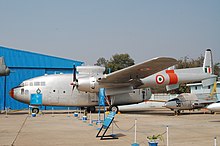| Tangail Airdrop | |||||||
|---|---|---|---|---|---|---|---|
| Part of the Bangladesh Liberation War and the Indo-Pakistani War of 1971 | |||||||
 A C-119 Boxcar of the Indian Air Force - the Tangail Airdrop relied heavily on these during the drop. | |||||||
| |||||||
| Belligerents | |||||||
|
|
| ||||||
| Commanders and leaders | |||||||
|
|
| ||||||
| Units involved | |||||||
|
95th Mountain Brigade
2 Para
|
93rd Infantry Brigade
| ||||||
| Strength | |||||||
|
2 Para ~750-1000 men |
93rd Brigade (Severely Understrength)
| ||||||
| Casualties and losses | |||||||
|
2 Para None |
93rd Brigade + Razakars 282 KIA 42 POW | ||||||
The Tangail Airdrop (11 December 1971) was an airborne operation conducted by the Indian Army in order to seize Poongli Bridge and ferry in the Tangail area. The operation, involving 2 Para of the Indian Army's Parachute Regiment is often regarded as one of the largest - if not the largest - airborne operation following World War 2. The operation saw the capture of all objectives and the repulsion of the Pakistan Army's 93rd Infantry Brigade which was attempting to withdraw to Dhaka to bolster its defence.[1]

- ^ MoD, History Division (1992). "Official History of the 1971 India Pakistan War" (PDF).
